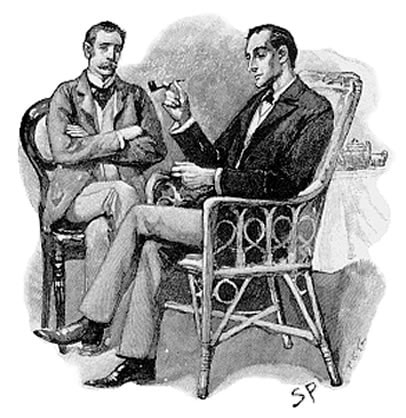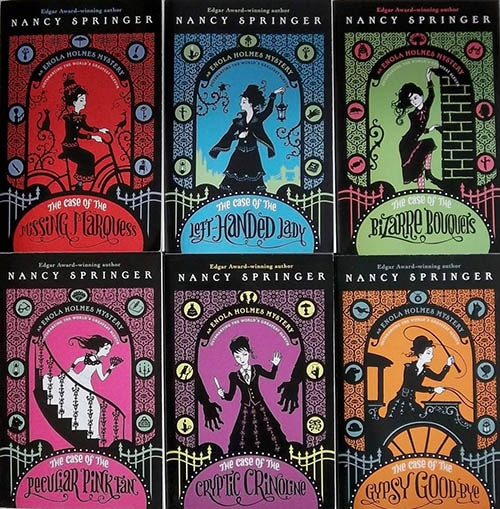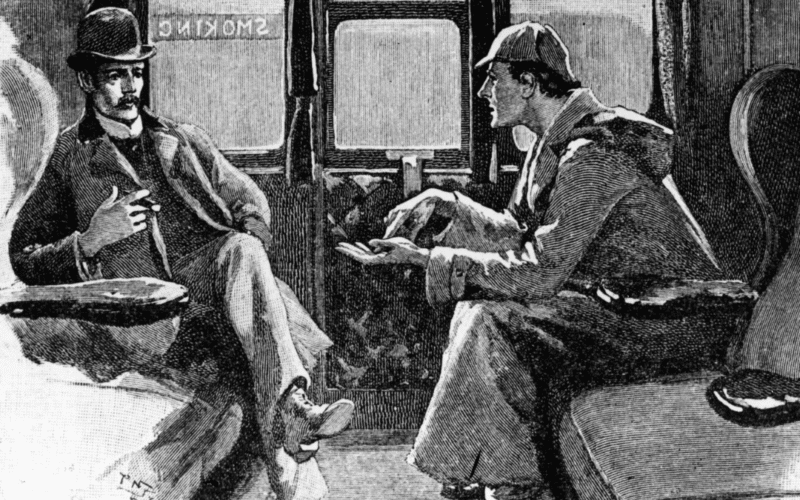The new Netflix film “Enola Holmes,” which features the imagined younger sister of famous literary detective Sherlock Holmes, is at the center of a copyright infringement lawsuit filed by the estate of Arthur Conan Doyle. The estate appears determined to squeeze every last drop of copyright life out of Holmes before the entire series falls into the public domain in 2023. Is the estate overstating its rights?
Last week, Netflix released the trailer for its upcoming film, in which Millie Bobby Brown (“Stranger Things”) plays the titular character “Enola Holmes,” an accomplished detective in her own right.
“Enola Holmes” is based on a series of young adult novels written by Nancy Springer and published beginning in 2006. While these books have apparently been coexisting in peace with the “Sherlock Holmes” canon for the past fifteen years, news of the motion picture version has prompted Conan Doyle’s estate to file a lawsuit in New Mexico district court. By the way, if anyone wants to write “Sherlock Holmes and the Case of Why a Literary Estate Based in the United Kingdom Filed a Lawsuit in New Mexico,” I’d read that book—as long as it had a better title.
The complaint, which asserts claims for both copyright and trademark infringement, was filed against author Springer and the books’ publisher Penguin Random House. Also named were the film’s producer Legendary Pictures, its distributor Netflix and even the director of “Enola Holmes,” Harry Bradbeer. If anyone wants to write “Sherlock Holmes and the Case of Why the Estate Felt the Need to Sue a Work-for-Hire Director Along with Everybody Else,” I’d read that book too. Again, you might want to think about changing the title.
Is there any merit to the estate’s case? Well, as Sherlock Holmes himself advised in 1891’s “A Scandal in Bohemia,” “It is a capital mistake to theorize before one has data.” So let’s look at the facts:
The “Sherlock Holmes” Works
Sir Arthur Conan Doyle wrote four novels and 56 short stories featuring his Sherlock Holmes character between 1887 and 1927. The vast majority of these works are already in the public domain. The 95 year copyright term of Conan Doyle’s last-published Sherlock Holmes story will expire in 2022, which means that as of January 1, 2023, the entire Holmes canon will be in the public domain in the United States. But as of today, the final six short stories featuring the character are still subject to copyright protection.
The Conan Doyle estate has a history of pushing the envelope when it comes to enforcing its claimed intellectual property rights. The fact that fully 90% of the Sherlock Holmes works are in the public domain hasn’t stopped the estate from taking the position that nearly anyone who wants to create a derivative work featuring the character needs to get a license. Among the licensed works touted on the Estate’s slickly-produced website are the long-running CBS series “Elementary,” the Will Ferrell comedy “Holmes and Watson” and two films starring Robert Downey, Jr.
The Klinger Case
When would-be producers and writers of new works featuring the Sherlock Holmes character didn’t obtain a license, the estate would often threaten litigation. In 2013, literary editor and Sherlock Holmes aficionado Leslie Klinger decided to take action after the estate threatened to stop distribution of his new Holmes anthology. Believing that the estate had overstated its remaining rights in the Sherlock Holmes character, Klinger filed his own lawsuit seeking a declaration that the Sherlock Holmes and Dr. Watson characters were no longer protected by federal copyright law.
Klinger acknowledged that the even though several (at that time, ten) of Conan Doyle’s Sherlock Holmes stories were still protected by copyright, the 50 stories in the public domain set forth the “essential characteristics” of the Holmes and Watson characters. Therefore, according to Klinger, the public was free to create new derivative works featuring these characters without the estate’s permission.

Conversely, the estate pushed for continued character protection in Sherlock Holmes, arguing that Arthur Conan Doyle created a “single complex character complete in sixty stories” over a thirty year period. If someone were to create a work that only used Holmes’ public domain traits, the estate argued, this would essentially give the character “multiple personalities.”
Klinger’s lawsuit thus began a debate about the nature of copyright protection in fictional characters which evolve over the course of many works.
In a 2014 opinion written by Judge Richard Posner of the Seventh Circuit, the court agreed with Klinger. The court held that “[w]hen a story falls into the public domain, story elements—including characters covered by the expired copyright—become fair game for follow-on authors.” And while later Holmes stories were still protected, copyrights in so-called “derivative works” only extend to the original protectable elements contained in those stories.
In other words, you can’t bootstrap your copyright in a derivative work to extend protection on the original work. Because Klinger was only looking to adapt the Holmes and Watson characters as they appeared in the stories that had lapsed into the public domain, he was free to do so.
However, Judge Posner’s opinion did offer a sliver of hope to the Conan Doyle estate, finding that:
[F]eatures of Holmes and Watson are depicted in the late stories that are not found in the early ones.… Only in the late stories for example do we learn that Holmes’s attitude toward dogs has changed—he has grown to like them—and that Watson has been married twice. These additional features, being (we may assume) “original” in the generous sense that the word bears in copyright law, are protected by the unexpired copyrights on the late stories.Klinger v. Conan Doyle Estate, Ltd.
Even though the Seventh Circuit had no occasion in Klinger to actually decide whether the examples mentioned by Judge Posner would rise to a level of expression sufficient to support a copyright claim, the Conan Doyle estate took the opening provided by the court’s opinion and decided to run with it.
The “Enola Holmes” Lawsuit
It’s now time for Enola Holmes to make her appearance. This character was introduced by author Springer in 2006, and has been featured in six novels aimed at more junior readers. Springer’s novels borrow characters and settings from the Sherlock Holmes canon alongside the Enola character, which is Springer’s own creation.

It doesn’t appear that the estate took any action against Springer or the “Enola Holmes” publisher for nearly fifteen years. But in April, Netflix announced that it had acquired distribution rights in a film based on the “Enola Holmes” book produced by Legendary Pictures. The film was original intended for a theatrical release, but in the wake of COVID-19, it will be streamed instead.

Following the Netflix announcement, the Conan Doyle estate filed its complaint. While the estate concedes that “the world is free to use and adapt” the Sherlock Holmes character as it is portrayed in the public domain stories, there are key attributes of the character that were only developed in the stories still protected by copyright:
When Conan Doyle returned to writing Sherlock Holmes stories after the war, he created significant new character traits for Holmes and Watson in the Copyrighted Stories . . . Conan Doyle made the surprising artistic decision to have his most famous character—known around the world as a brain without a heart—develop into a character with a heart. Holmes became warmer. He became capable of friendship. He could express emotion. He began to respect women.
Complaint, Conan Doyle Estate, LLC v. Springer
So, for anyone who’s been patiently waiting for a court to decide whether respecting women is a character trait protected by copyright law, you just might get your chance.
The estate also alleges that Springer’s works copy “Sherlock Holmes’s warm friendship with Watson” because nowhere in the public domain stories does “Holmes express such emotion about the well-being of his companion.”
In short, the estate’s position is that the “Enola Holmes” works infringe Holmes version 2.0, because they “make extensive infringing use of Conan Doyle’s transformation of Holmes from cold and critical to warm, respectful, and kind in his relationships.”
The film-related defendants recently filed an answer to the Conan Doyle estate’s complaint. Among other defenses, they assert that the estate’s conduct with respect to Sherlock Holmes constitutes “copyright misuse.” This is an area I’ve litigated before. Copyright misuse can occur when a copyright owner attempts to leverage the limited monopoly granted by the Copyright Act to control areas that aren’t protected by copyright. So here, the argument would be that the estate is essentially trying to leverage its two more years of copyright protection in a handful of Sherlock Holmes stories to effectively control a character that’s more than 130 years old and mostly in the public domain.
So who’s right? Well, as you probably guessed by the title of this post, I think the estate is overreaching here. One way to frame this issue is to imagine that there are no similarities between Conan Doyle’s works and the “Enola Holmes” version of the character other those identified by the estate. In other words, if we filter out all of unprotected (i.e., public domain) aspects of Sherlock Holmes, we’re left with a comparison between two characters, both of whom (1) respect women and (2) have a friendly relationship with their long-time partners. If this were in fact the only protectable expression shared by the two works, its hard to believe that these character attributes would rise to the level of “substantial similarity” required to prove copyright infringement.
I also think the estate is reading too much into Judge Posner’s opinion in Klinger. Sure, character features found solely in the copyrighted Sherlock Holmes works (such as Holmes’ “attitude toward dogs”) may be protectable. But this doesn’t mean that the mere presence of those features in another work is necessarily infringing, as the estate appears to claim in the “Enola Holmes” case.
Interestingly, some hard core Sherlock Holmes fans have pointed out that even the factual premise underlying the estate’s complaint is wrong. For example, in a recent article in “Den of Geek,” Ryan Britt claims that any true Holmes fan knows that the idea that the character only began to “respect women” in the later stories published in the 1920’s is “laughably false.” As an example, he points to “The Man With the Twisted Lip” (1891), in which Holmes remarked, “I have seen too much not to know that the impression of a woman may be more valuable than the conclusion of an analytical reasoner.”
Can Trademark Law Revive Sherlock Holmes?
Finally, there’s the issue of trademark law. In addition to its copyright infringement claim, the Conan Doyle estate contends that the defendants’ use of “Enola Holmes” for a book series and a film are likely to confuse the public into believing that the estate has sponsored, endorses or is otherwise affiliated with those projects. In other words, the estate appears to be asserting that because it has successfully insisted on obtaining a license for so many years, the public has come to expect that any Holmes derivative carries the imprimatur of the estate.
The trademark claim seems particularly overreaching given the circumstances surrounding the Holmes copyrights. If the estate could use its claimed trademarks in such terms as HOLMES, SHERLOCK HOLMES and HOLMES AND WATSON to altogether prevent people from creating derivative works, this would essentially give the estate perpetual exclusive rights in a public domain character. In 2003, Justice Scalia, writing for the Supreme Court in Dastar Corp. v. Twentieth Century Fox, warned that allowing these types of restrictions on a public domain work could effectively create “a species of mutant copyright law” that would limit the public’s right to copy and use expired copyrights.
So far, there’s no sign that the Conan Doyle estate is seeking a preliminary injunction to prevent Netflix from streaming “Enola Holmes,” which means that on September 23, we’ll all be able to judge the case for ourselves. Meanwhile, if anyone can solve the mystery about why the lawsuit was filed in New Mexico, let us know in the comments below.
UPDATE—It appears the parties have reached a settlement in the case, as a stipulation to dismiss with prejudice was filed with the court on December 18, 2020. Read more here.







4 comments
“The world is full of obvious things which nobody by any chance ever observes.”
[*The following to be read in a Dwight Schrute voice*]
FACT: The New Mexico District Court where the Estate filed its complaint is located just 42 minutes drive from Moriarty New Mexico. (Not named after the Sherlock Holmes villain, but never mind that.)
(https://www.nmd.uscourts.gov/court-info/court-locations)
FACT: Beginning in 1971, Moriarty New Mexico was home to annual dinners hosted by “The Brothers Three of Moriarty,” a “Scion Society of the Baker Street irregulars,” led by John Bennett Shaw (who died in 1994). (https://www.johnbennettshaw.com/)
FACT: The Brothers Three of Moriarty held their annual dinners at the Frontier Saloon (201 E Central Ave, now permanently closed). You can read all about it in Sonia Fetherston’s report on “The Folks From Moriarty.”
“…when you have eliminated all which is impossible, then whatever remains, however improbable, must be the truth.”
[Insert crazy Dwight Schrute conspiracy theory here]
https://memegenerator.net/instance/41991043/dwight-schrute-fact-you-are-reading-this-in-my-voice
The mystery of why the case was filed in New Mexico when none of the parties live there has been solved! According to the Conan Doyle estate’s opposition to a motion to transfer the case to Los Angeles:
“The Estate’s only United States shareholder is also its licensing representative, Jon Lellenberg, who lives and works in Santa Fe, New Mexico. He has represented the Estate and its predecessor Dame Jean Conan Doyle for nearly forty years. The Estate’s files and witnesses relating to its copyright and trademark ownership are in New Mexico. Mr. Lellenberg is also a Conan Doyle and Sherlock Holmes scholar, having written, edited, or contributed to more than twenty books in those areas. If a trial is needed, he may be a witness. ”
Doesn’t seem like a very strong reason to keep the case in DNM when all of the witnesses are elsewhere, but that’s for the court to decide.
I mean seriously, you can come to an idea of characters growing emotions from ANY source, I don’t need to read any copyrighten books to think it’d be a good idea to give a character emotions. Character development and emotions are staple to any form of storytelling, I don’t need to read any of the later books to figure out there is more to Sherlock than just his emotionless shell, I could do that with any character I adapted, regardless of whether later books have it or not. Even if those books didn’t exist period, I would’ve still come to the same conclusion, because that’s the kind of storyteller I am.